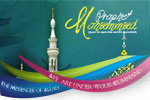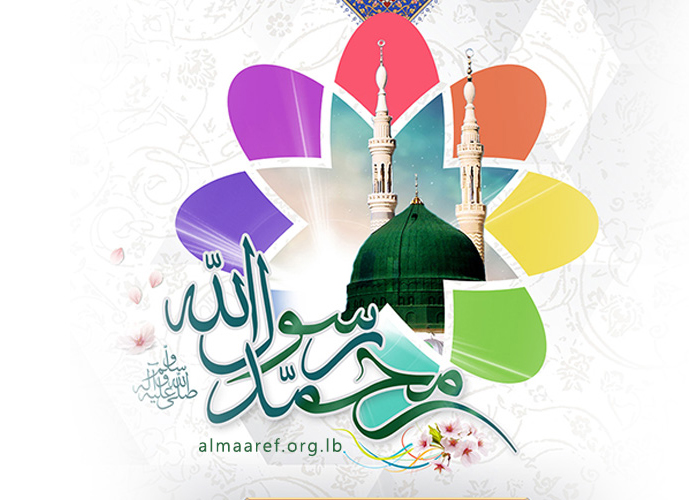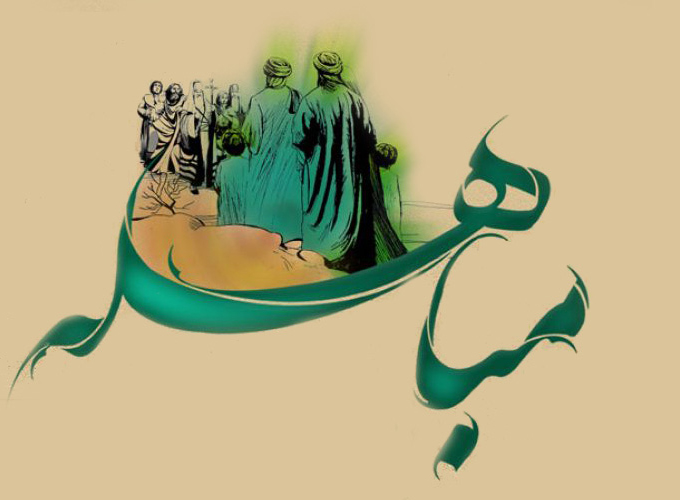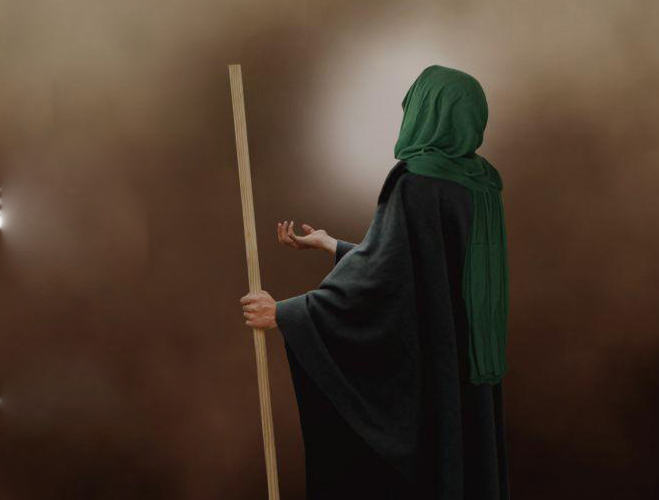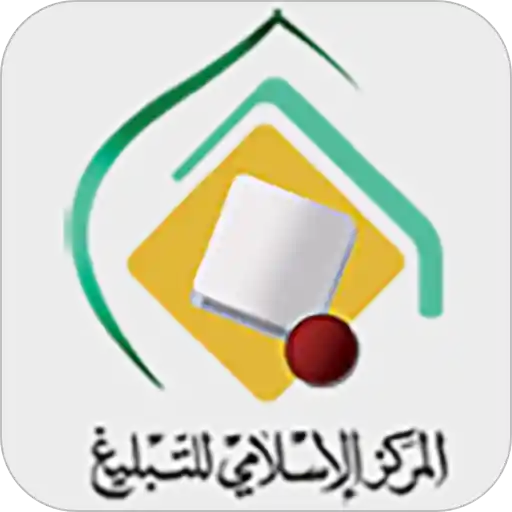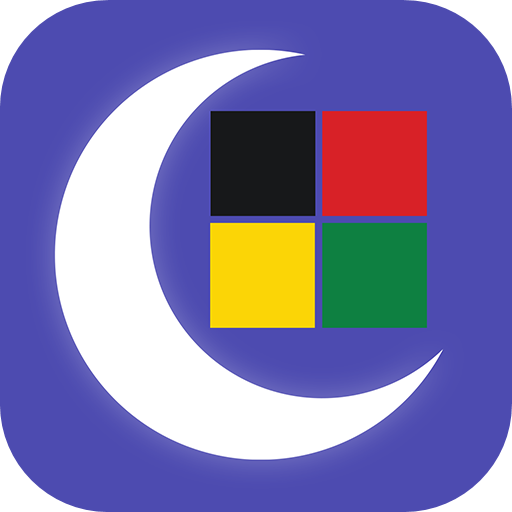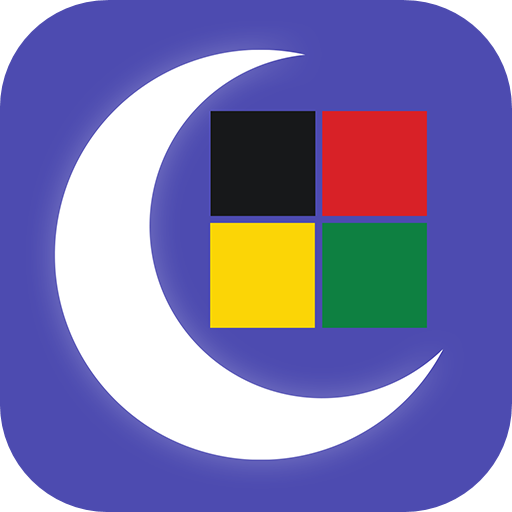One of the highlights in the life of the great Prophet Muhammad (SA) is the fact
that he was untrained and unschooled (ie, he did not attend any school). He had
not been trained by any teacher and neither he had acquainted himself with any
written work.
No historian, Muslim or non-Muslim, can be found who would claim that the
Prophet (SA) had been taught to read or write by anyone in his childhood or
youth, let alone during his old age, which was the time of his mission. No one
has ever either indicated an instance of the Prophet (SA) having read or written
a line.
The Arabs, particularly those from Hijaz, were generally unlettered during that
period, and those of them who could read and write were very well-known and very
few in number. It would, as a rule, be impossible for a man to learn this skill
under such conditions and not be well-known for this virtue among the people.
As we know, and will be later discussed, at William James Durant remarks:
"Evidently no one thought of teaching him (the great Prophet) reading and
writing. At that time the art of reading, and writing was of little significance
to the Arabs. For this very reason, there were no more than seventeen persons
among the Quraysh tribe who could read and write. It is not known that Muhammad
himself should have written anything. After his appointment as Prophet, he had a
special scribe for him. Yet the most popular and eloquent Arabic book was
recited by him. He had a better acquaintance and grasp of the affairs than the
educated ones".'1
John Davenport in his book entitled: "Apology for Fault to Muhammad and Qur'an"
observes: "As regards education, such as is usual throughout the world, it is
the general belief that Muhammad had no education other than that which was
commonly practiced in his tribe".2
Constante Vergil Giorgio in his book entitled: "Muhammad - a Prophet to Be
Acquainted with Afresh" remarks: "Although he was unschooled, the early verses
sent down to him spoke of the pen and knowledge; namely of writing, putting into
writing, learning, and of teaching. In no other major religion has knowledge
been so extensively appreciated, and no other religion can be found in which
such an importance has been attached to knowledge, at its initial stage of
development. Had Muhammad been a scholar, no surprise would be caused at the
verses having been sent down into the Ghar Hira' (Hira' Cave), since a scholar
appreciates knowledge, but the Prophet was neither schooled nor tutored. I
congratulate the Muslims on their religion having so dearly regarded, at its
inception, the acquisition of knowledge".3
Gustav Lubon in his famous work: "The Civilization of Islam and the Arabs"
notes: "It is well-known that the Prophet was unschooled. This stands to reason
also by appealing to inductive generalization, that if he happened to be
knowledgeable, the contents and paragraphs of Qur'an would have been better
interrelated. Furthermore, if Muhammad was not unschooled, he would not have
been capable of propagating a new religion, for an unschooled person is better
aware of the needs of the common (illiterate) people and thus is more capable of
helping them to the right path. However, whether the Prophet was schooled or
unschooled, undoubtedly, he was possessing the highest degree of intellect,
wisdom and awareness". 4
Not being conversant with the Qur'anic concepts, materialistically oriented
Gustav Lubon fabricates nonsensical words concerning the relationships of
Qur'anic verses and the incapability of the educated to understand the needs of
the uneducated, thus insults the Qur'an and the Prophet (SA). Yet he admits that
there is no recorded evidence or indication concerning the Prophet (SA) having
been able to read and write.
I am not intending to seek supportive evidence by quoting the above. The Muslims
and the easterners themselves are better qualified to comment on the history of
Islam and the east. My purpose in bringing in the above quotations is for
letting the readers know that had there been the slightest indication to this
effect, it would not have escaped the inquisitive and critical attention of
non-Muslim historians.
In the course of his journey to Damascus, the great Prophet (SA), accompanied by
Abu Talib (AS), stayed at a resting place on his way, during which he had a
brief meeting with a monk named Buhayra.5 This meeting has diverted
the attention of the orientalists to this question that the Prophet (SA) might
have been taught through this short meeting. When an incident as insignificant
as this, attracts the attention of his old and new enemies, had there ever been
some record testifying the Holy Prophet's knowledge of reading and writing, it
would have not remained hidden from them, but, it would rather have been
magnified several times.
For clarification, the point will be discussed in two parts: (1) The
Pre-prophetic period; and (2) The Post-prophetic period.
The post-prophetic period, will also be discussed in two parts: (i) Writing; and
(ii) Reading
Later on, it will be concluded that it is unanimously agreed upon, by both
Muslim and non-Muslim scholars, that before his prophetic mission the Prophet
(SA) had not the slightest acquaintance with either reading or writing. However,
during the post-prophetic period it is not very certain. During the
post-prophetic period what is more certain is that he could not write; however,
the fact that he could not read is not so certain. It can be concluded from
certain Shi'i accounts that he could read but not write during the
post-prophetic period. Although Shi'i accounts are also not unanimous in this
respect. What can be inferred from the various pieces of evidence is that he
neither read nor wrote during the post-prophetic period also.
In order to study the pre-prophetic period, we need to discuss the general
conditions which prevailed in, what is now, Saudi Arabia during that period from
the viewpoints of reading and writing.
It is inferred from historical accounts that those who could read and write at
the advent of Islam were very few in number.
2. The Development Of Calligraphy In Hijaz
In the end of the book: "Futuh al-Buldan", Al-Baladhuri thus describes the early
development of calligraphy in Hijaz: "First there were three men of the tribe `Tay'
(in the vicinity of Syria) who initiated the Arabic handwriting and compared the
Arabic alphabets to the Syriac ones. Later, some men from Anbar learned the
alphabets from these men. The inhabitants of Hirah learned the handwriting from
the inhabitants of Anbar. Bushr ibn `Abd al-Malik al-Kindi, brother of Al-Ukaydir
ibn `Abd al-Malik al-Kindi, ruler of Dumat al-Jandal, who was a Christian,
learned the Arabic handwriting in the course of his trips to and from Hirah.
This same Bushr went on a business trip to Makkah, where he was seen writing by
Sufyan ibn Umayyah (Abu Sufyan's paternal uncle) and Abu Qays ibn `Abd Munaf Ibn
Zuhrah. They asked him to teach them writing and he did so. Later, this very
Bushr, accompanied by the other two, made a Business trip to Ta'if, where
Ghaylan ibn Salamah al-Thaqafi learned the writing from them. Subsequently,
Bushr parted from the other two for a trip to Egypt. `Amr ibn Zurarah, who later
became known as" `Amr - the Scribe", learned writing from Bushr who then went to
Damascus where many learned the writing from him."
In his book entitled: "Al-Fihrist", under the first part of the initial paper,6
Ibn al-Nadim makes reference to certain quotations of Al-Baladhuri. Ibn al-Nadim,
quoting Ibn 'Abbas, notes that the first people to write in the Arabic script
were three men from the tribe of "Bulan" in Anbar. Inhabitants of Anbar learned
to write from the inhabitants of Hirah.
Ibn Khaldun too, in his introductory chapter:
"Fi Annal-Khatta wa al-Kitabah min `Idad al-Sana'i ` al-Insaniyyah", refers to
and confirms Al-Baladhuri's words.7
By quoting authentic narrations, Al-Baladhuri narrates that at the advent of
Islam there were only a few literate persons. He says:
"At the advent of Islam there were only seventeen men who could write, namely: `Umar
ibn al-Khattab, `Ali ibn Abi Talib (AS), `Uthman ibn `Affan, Abu `Ubaydah al-Jarrah,
Talhah, Yazid ibn Abi Sufyan, Abu Hudhayfah ibn Rabi'ah, Hatib ibn al-`Amiri,
Abu Salamah al-Makhzumi, Aban ibn Sa'id al-'Umawi, Khalid ibn Said al-Umawi,
`Abdullah ibn Sa'd ibn Abi Sarh, Huwaytib ibn `Abd al-`Uzza, Abu Sufyan ibn Harb,
Mu'awiyah ibn Abi Sufyan, Juhaym ibn al-Salt, and `Ala' ibn al-Hadirami who was
not from the Quraysh but rather an ally of the Quraysh."
Al-Baladhuri names only one Quraysh lady, Shifa', the daughter of `Abdullah `Adawi,
who could read and write in the Age of Ignorance concurrent with the advent of
Islam. Later, she professed Islam and was regarded as one of the early
emigrants.
Al-Baladhuri observes,:
"This lady is one and the same person who taught Hafsah, the wife of the Prophet
(SA), to write. One day, the Prophet (SA) said to Shifa': `It will be a good
thing if you teach Hafsah `Ruqyat al-Namlah,8 as you taught her
writing'."
Then, naming some Muslim women who could both read or write, or both, Al-Baladhuri
reports:
"Hafsah, the wife of the Prophet (SA), could write, so could Umm Kulthum, the
daughter of `Uqbah ibn Abi Muit (one of the women who emigrated early). `A'ishah,
daughter of Sa'd said that her father taught her to write. Karimah, daughter of
Miqdad, could also write. `A'ishah (the wife of the Prophet) could read but not
write, and Umm Salamah stood in a similar condition."
Continuing to mention the names of men who served as scribes for the Prophet
(SA), Al-Baladhuri reports that at a time concurrent with the advent of Islam,
there were only eleven men -whose names he mentions - from the two tribes Al-Aws
and Al-Khazraj stationed in Madinah, who knew the art of writing.
It becomes clear that the art of writing had only recently been introduced into
Hijaz, and that the circumstances were then such that, if anyone happened to
know reading or writing, he would be known far and wide. Those in Makkah or in
Madinah, who knew this art, at a time concurrent with the advent of Islam, were
well-known, and very few in number. For this reason they had their names
registered in history. If the Prophet (SA) had been among them he would have
been regarded likewise. Since there has been no mention of the Prophet among the
above, it becomes clear that he had nothing to do with either reading or
writing.
3. The Prophetic Period (In Particular, The Madinah Period)
It can be inferred from the evidence available that the Holy Prophet (SA)
neither read nor wrote in the period of his prophethood. However, Shi'i and
Sunni scholars have different opinions on this matter. Some have considered
improbability of this issue as they say: "How is it possible that the wahy
(revelation), which used to teach everything, has not taught him to read and
write?9
It has been mentioned in several Shi'i narrations that the Prophet (SA) could
read in the period of prophethood but could not write.'10 One of
these narrations is in Saduq's book: `Ilal al-Shara'i`. It reads:
"One of Allah's gifts to His Prophet was that he read but did not write. The
time when Abu Sufyan headed for 'Uhud, Al-`Abbas, the Prophet's uncle, wrote a
letter to him. He received the letter when he was in one of the gardens near
Madinah. He read the letter but did not make his Companions aware of its
contents. He ordered them to go to the city and there he let them know about
that."''11
This story is different in Zayni Dahlan's book: "Sirah". It relates:
"As soon as the Prophet received Al-`Abbas's letter, he opened its seal and
handed it over to Ubay ibn Ka'b to read. Ka'b read it, and the Prophet ordered
him not to spread out the news. Then, the Prophet went to Sa'd ibn al-Rabi`, the
famous companion, informed him of the contents of the letter and asked him too,
not to reveal it. "12
Some others believed that the Prophet (SA) could both read and write in the
period of prophethood. Sayyid Murtada - as is mentioned in Bihar al-Anwar -
states: "A group of scholars hold the belief that the Holy Prophet did not die
until he was able to read and write."13 Sayyid Murtada himself relies
on the well-known tradition: `ink and pen' and says: "That the Prophet asked
(those close to him) for ink and pen to write instructions lest they might go
astray after his death, has been transmitted through reliable narrations and
histories. "14
It is however inappropriate to rely on this tradition, for it does not openly
indicate that the Holy Prophet (SA) intended to write with his own hand. Even if
we assume that he intended to have someone write, in the presence of the people,
and thus have them as witnesses, using the statement: "I want to write something
for you lest you should go astray" is quite acceptable. In literature, this is
called `metaphorical attribution'. It is one of the signs of eloquence and is
used widely in Arabic as well as other languages.
* The Unschooled Prophet. By (Martyr) Murtadha Mutahhari.
Published by: Islamic Propagation Organization. Tehran, Islamic Republic of
Tehran.
1- William
James Durant, "History of Civilization (Persian Version)", vol II, p 14.
2- John Daven port, "Apology for Fault to Muhammad and Qur'an", 3rd print, p 17
and 18.
3- Constante Vergil Giorgio, "Muhammad - a Prophet to be Acquainted with
Afresh", 1st edition, p 45.
4- Gustav Lubon, "The Civilization of Islam and the Arabs", 4th edition, p 20.
5- Prof Massinion, the known Islamologist and orientalist, in his book: Salmane
Pak (The Holy Salman) questions even the existence of such a person let alone
his meeting with the Prophet (SA) and regards him as a fictitious character. He
observes: "Buhayri Sergius, Tamimdari and others who have collected traditions
concerning the Prophet are ghosts of a doubtful and intangible nature".
6- Ibn al-Nadim, Al-Fihrist, published by the Al-Istiqamah Press, Cairo, p 13.
7- Ibn Khaldun, Al-Muqaddamah (Introduction), Ibrahim Hilm'i Press, p 492.
8- In the book: Futuh al-Buldan, printed at Al-Sa'adah Press, Egypt, 1959, this
word has been entered as 'Ruqnat al-Namlah', which is certainly a misprint. The
correct term, as recorded 'Naml' in Ibn al-Athir's Al-Nihayah is "Ruqyat al-Namlah"'
"Ruqyah" were sentences of the incantation type which were recited and believed
to be effective in warding off evil, or diseases. As regards "Ruqa", Ibn al-Athir
reports that certain accounts of the Prophet (SA) recommend and others prohibit
the use of "Ruqa" Ibn al-Athir, himself claims accounts of the prohibitive type
concern" seeking refuge in other than Allah's name, that man should shift his
dependence on Allah and rely upon things other than seeking refuge in the name
of Allah", accounts of the recommending type concern the fact that man should
depend on divine names and seek His (Allah's) help.
As regards 'Naml', Ibn al-Athir reports:
"What is known as 'Ruqyat al-Namlah' was not in reality of Ruqa like nature,
rather they were well-known sentences which everyone knew would neither harm nor
benefit. The Prophet (SA) addressed Shifa' in a jocular language with these
words as a gesture to his wife Hafsah. The words were: "The bride sits hennaed
with dark-dyed eyelids in the centre of the crowd, doing everything except
disobeying her husband."
Such sentences were referred to as "Ruqyat al-Namlah". Apparently, in so saying,
a kind of joke and satire has been employed. Ibn al-Athir maintains:
"The great Prophet (SA) addressed Shifa' in jocular and satirical language,
saying that it would be a good thing if she taught Hafsah "Ruqyat al-Namlah" as
she had taught her writing , a. suggestion that Hafsah disobeyed the Prophet
(SA) by disclosing the secret told her by the Prophet (SA).
9- Bihar al-Anwar, new print, vol 16, p 134.
10- Ibid , p 132.
11- Ibid , p 133,
12- Zayni Dahlan, Sirah, vol 2, p 24.
13- Biharal-Anwar, new print, vol 16, p 135.
14- Ibid.


